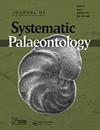A new podocnemidid (Pleurodira: Pelomedusoides) from the Eocene of north-western Argentina, with comments on its evolutionary relationships and palaeoenvironmental settings
IF 2.2
2区 地球科学
Q3 EVOLUTIONARY BIOLOGY
引用次数: 2
Abstract
We report a new small podocnemidid, Gestemys powelli gen. et sp. nov., based on one nearly complete skull, lower jaw, two shells, and remains of the appendicular skeleton belonging to two specimens from the Eocene Geste Formation of the San Antonio de la Cobres Basin, Salta Province, north-western Argentina. As in other podocnemidid genera, Gestemys exhibits a fully developed and medially extensive cavum pterygoidei, an incisura columellae auris enclosing the stapes and Eustachian tube, and lacks an exoccipital quadrate contact. Gestemys powelli bears a huge foramen palatinum posterius and a short pterygoid flange that does not reach the basisphenoid suture, exposing the cavum pterygoid. Phylogenetic analyses place Gestemys powelli as a member of Podocnemididae more closely related to Erymnochelyinae than Podocnemidinae. In regards to the palaeoenvironmental settings of the Palaeogene formations (Maíz Gordo and Geste) of north-western Argentina, at least two features differentiate the palaeoenvironment where G. powelli was recovered and those of other podocnemidid turtles from the Maíz Gordo Formation: 1) G. powelli was found in situ with very little re-working; and 2) in contrast to the muddy rocks indicating the marginal lacustrine setting and humid climate of the Maíz Gordo Formation, G. powelli is associated with a coarse-grained floodplain setting and a dry, temperate climate. Such differences highlight the contrasting environmental dynamics in which podocnemidid turtles lived during the Palaeogene. http://zoobank.org/urn:lsid:zoobank.org:pub:0E631DA2-053F-4BD6-91BD-2401F34A5777阿根廷西北部始新世的一种新的足类动物(Pleurodira:Polomedusoides),并对其进化关系和古环境背景进行了评论
本文报道了阿根廷西北部萨尔塔省圣安东尼奥盆地始新世Geste组的两个标本的一个几乎完整的头骨、下颚、两个贝壳和尾骨残骸,发现了一种新的小型足跖恐龙,Gestemys powelli gen. et sp. nov.。与其他足足动物属一样,Gestemys具有发育完全且向内侧延伸的翼状窝,封闭镫骨和耳咽管的耳小柱切孔,缺乏枕骨外方体接触。巨齿蝶具有巨大的腭后孔和短的翼缘,翼缘不能到达基底突缝线,暴露出翼突腔。系统发育分析表明,与足鼠亚科相比,足鼠亚科与足鼠亚科的亲缘关系更为密切。就阿根廷西北部古近系(Maíz Gordo和Geste)组的古环境背景而言,至少有两个特征可以区分出powelli龟与Maíz Gordo组其他足爪龟的古环境:1)powelli龟是原位发现的,几乎没有再加工;2)与表明Maíz Gordo组边缘湖相环境和湿润气候的泥岩相比,G. powelli与粗粒洪泛平原环境和干燥温带气候有关。这些差异突出了古近纪足爪龟生活的环境动力学的对比。http://zoobank.org/urn:lsid:zoobank.org:pub:0E631DA2-053F-4BD6-91BD-2401F34A5777
本文章由计算机程序翻译,如有差异,请以英文原文为准。
求助全文
约1分钟内获得全文
求助全文
来源期刊
CiteScore
5.30
自引率
7.70%
发文量
31
审稿时长
>12 weeks
期刊介绍:
The Journal of Systematic Palaeontology publishes papers that provide novel and impactful results in phylogenetics and systematics and that use these results in ways that significantly advance rigorous analyses of palaeogeography, palaeobiology, functional morphology, palaeoecology or biostratigraphy. Papers dealing with theoretical issues or molecular phylogenetics are also considered if they are of relevance to palaeo-systematists. Contributions that include substantial anatomical descriptions, descriptions of new taxa or taxonomic revisions are welcome, but must also include a substantial systematics component, such as a new phylogeny or a revised higher-level classification. Papers dealing primarily with alpha-taxonomic descriptions, the presentation of new faunal/floristic records or minor revisions to species- or genus-level classifications do not fall within the remit of the journal.

 求助内容:
求助内容: 应助结果提醒方式:
应助结果提醒方式:


